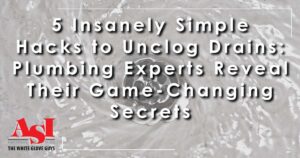Measuring your pipes doesn’t need to be a difficult task. Making sure that your pipes are measured will help make the installation process much easier. We will explain the different methods to measuring your pipes and give you tips on installing them on your own.
How You Can Measure Your Plumbing Pipes
There are many different types of plumbing materials so measuring them can be different depending on what kind you have. The main two measurements that plumbers are concerned about are the Nominal Pipe Size (NPS) and the Outside Diameter (OD).
How You Can Tell What Size Pipe You Have
On the pipe itself is where you can find the size of the pipe. The NPS will be printed or labeled on all fittings and plumbing pipes. For instance, plastic plumbing pipes will have the kind of plastic it is made from, the size, and thickness printed on the side while copper pipes will be labeled with the type of copper the pipe is made from.
Measuring Pipe Sizes
Measuring pipes can be done by a few different methods. We’ll go over each of them with you.
Copper Pipe NPS Reference Chart
| Copper Pipe Size | Outside Diameter | Pipe Circumference |
| 1/2″ | 5/8″ | 2″ |
| 3/4″ | 7/8″ | 2-5/8″ |
| 1″ | 1-1/8″ | 3-1/4″ |
| 1-1/4″ | 1-3/8″ | 4-1/8″ |
| 1-1/2″ | 1-5/8″ | 5-1/8″ |
| 2″ | 2-1/8″ | 6-5/8″ |
| 3″ | 3-1/8″ | 9-3/4″ |
| 4″ | 4-1/8″ | 13″ |
PVC, ABS, CPVC, Brass, and Steel Pipe NPS Reference Chart
| Plastic/Metal Pipe Size | Outside Diameter | Pipe Circumference |
| 1/2″ | 7/8″ | 2-5/8″ |
| 3/4″ | 1-1/8″ | 3-1/4″ |
| 1″ | 1-3/8″ | 4-1/8″ |
| 1-1/4″ | 1-5/8″ | 5-1/4″ |
| 1-1/2″ | 1-7/8″ | 6″ |
| 2″ | 2-3/8″ | 7-1/2″ |
| 3″ | 3-3/8″ | 11″ |
| 4″ | 4-3/8″ | 14-1/8″ |
Direct Diameter Measurement
A very easy way to get the pipe’s OD is to measure the direct diameter. If your pipe is already installed this method won’t work for you as you need the open end of the pipe. Use a measuring tape or ruler and measure directly across the end of the pipe. This will give you the direct diameter measurement.
Outside Diameter Measurement
Another easy way to measure your pipe’s size is to use calipers and measure the outside diameter of the pipe. This is a good option if your pipe is already installed.
Circumference Measurement
There is a little bit of math involved when it comes to measuring your pipe’s circumference. However, we’ll explain it so that it’s easier to understand. Wrap a string or flexible tape around the pipe and make a mark.
Measure the length of the string or tape and divide that measurement by pi (pi=3.1415). This equation will give you the pipe’s diameter. To find the NPS cross-reference the measurement with the above charts.
Tips For Pipe Installation
Installing your pipes yourself may be a good option if you are only replacing or repairing a single broken or old pipe. Larger, more complex pipe replacements should be done by a licensed plumber. Below are some tips to help you get your water pipes installed.
Use PEX Pipes
One piping material that you should consider using is PEX. This is a plastic pipe that is usually less expensive than other kinds. It is flexible, cuts easily, and can be attached to other pipes by using simple fittings. You will have a much smoother installation process with this type of pipe material. It’s ideal if you’re replacing a smaller area of your water pipes.
Confirm You Have The Correct Size Pipe
First, you should always check your local codes to make sure you are using the correct size pipe. Before you start your plumbing project make sure that you are using the right size pipe as these are very specific to plumbing systems. Since you’ve already learned how to measure your pipes, this should be easy.
Try To Keep Pipe Materials Uniformed
Corrosion can occur in your plumbing system when two different types of metals or materials come in contact with each other. Make sure to check what material the old pipes are made out of before you begin your project. If you are not able to avoid using a different material, specific fittings can be used to prevent problems.
Check Fittings
A fitting is part of a plumbing system that attaches two pipes together and usually has the purpose of redirecting water. If your fittings are not adhered to both pipes properly you can have issues with leaks in your pipes. Different materials will require certain fittings so checking these can help make the process easier for you.
Dry Fit Your Pipes
Since pipe size is so critical to having a good plumbing job, it’s important to dry-fit the pipes prior to permanently attaching them together. This can ensure that your pipes will function correctly when they are installed.
The licensed plumbers at ASI Heating and Air are here to make sure your pipe installation goes well. Give us a call today to schedule your installation!









